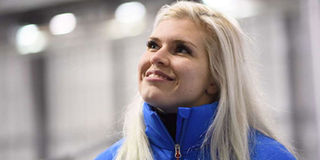Lone woman fights it out in tough Paralympics sledge hockey

In a photo taken on March 11, 2018, Paralympic ice hockey player Lena Schroeder of Norway attends a training session at the Gangneung Hockey Centre in Gangneung during the Pyeongchang 2018 Winter Paralympic Games. PHOTO | ED JONES |
What you need to know:
- Norway's Lena Schroeder zips over the ice strapped onto a sledge, colliding with other players and taking shots — the only woman player in the toughest sport at the Winter Paralympics.
- Unlike Olympic ice hockey, which has separate men's and women's teams, "sledge ice hockey" played at the Paralympics is technically mixed.
- But the 24-year-old is the first woman to compete in the discipline at the Games since 1994, and the only female player out of 135 at the Pyeongchang Paralympics in South Korea.
PYEONGCHANG
Norway's Lena Schroeder zips over the ice strapped onto a sledge, colliding with other players and taking shots — the only woman player in the toughest sport at the Winter Paralympics.
Unlike Olympic ice hockey, which has separate men's and women's teams, "sledge ice hockey" played at the Paralympics is technically mixed.
But the 24-year-old is the first woman to compete in the discipline at the Games since 1994, and the only female player out of 135 at the Pyeongchang Paralympics in South Korea.
Sledge ice hockey is the most fast and furious sport — and the most popular among spectators — at the Winter Paralympics.
Athletes who have lost full or partial use of their legs are strapped into small sledges with two blades on the bottom, and use two short sticks to push themselves across the ice and shoot.
The sport can be just as violent as the able-bodied version. Vicious tackles and clashes on the ice are common, and participants are kitted out with heavy padding and helmets.
But Schroeder does not consider her gender a barrier to participation at the highest level.
At a practice session Sunday, she happily zipped across the ice, her blonde hair flowing from the back of her helmet, passing the puck and taking shots.
"I'm so used to being the only female player," she said.
"I think everyone is so used to it — I've been part of the team for so many years."
'Boy or girl, it's the same'
For the other players on the 18-strong squad, she is just another member of the team.
"If she's a boy or girl, it's the same," team-mate Magnus Bogle told AFP.
"There is no difference — if you are in the locker room, you are in the locker room."
Schroeder was born with spina bifida, which occurs when the spine and spinal cord don't form properly, and has lost most use of her legs.
After trying out several sports for disabled athletes, she finally settled on sledge ice hockey at the age of 15.
It was no easy task for her to win a coveted spot on the national team in winter sports-mad Norway, which is the most decorated team in the history of Paralympic hockey.
She trains five times a week, for both the national team and her local outfit in Oslo, and has deferred her university medical studies so she can take part in the Paralympics.
As well as the national and Oslo teams, she plays on a European squad that includes players from several countries who team up for showdowns against heavyweights the USA and Canada.
The USA are current Paralympic champions, while Canada are reigning world champions. The two are expected to fight it out for gold and silver in the final on Sunday.
Norway and a handful of other teams will likely be left battling for bronze, although the Norwegians got off to a disappointing start with a 3-2 loss to Italy at the weekend.
It is hard for the Paralympians to match the success of their compatriots in the Winter Olympics — Norway, with a population of just five million, topped the medals table at last month's Games in Pyeongchang.
By contrast, Norway only came 11th in the medals standings at the 2014 Paralympics.
However, the hockey team is hoping it can be one of Norway's success stories at the Games. They want to bounce back in Pyeongchang after coming fourth in Sochi in 2014, failing to win a hockey medal for the first time at a Paralympics.
Schroeder can make a point, too. She hopes her success can show other aspiring female hockey players that "they can play at a high level, too, with the guys and that it is never a problem that you're a female player".





